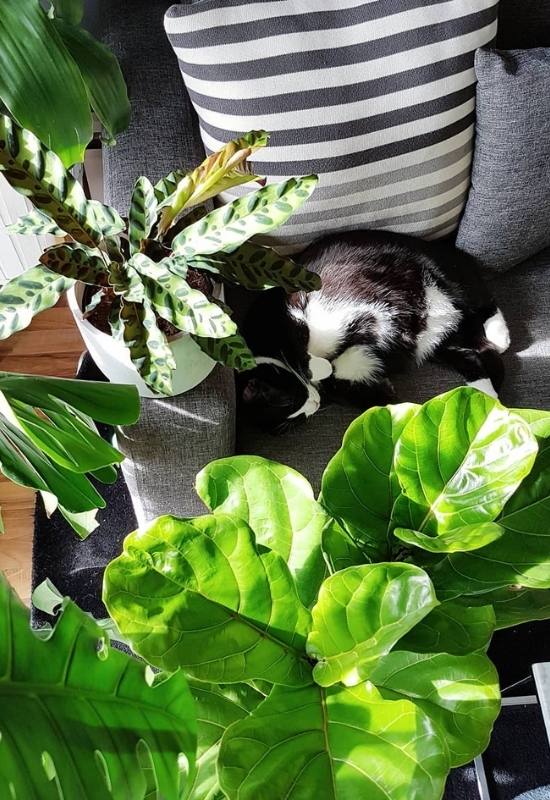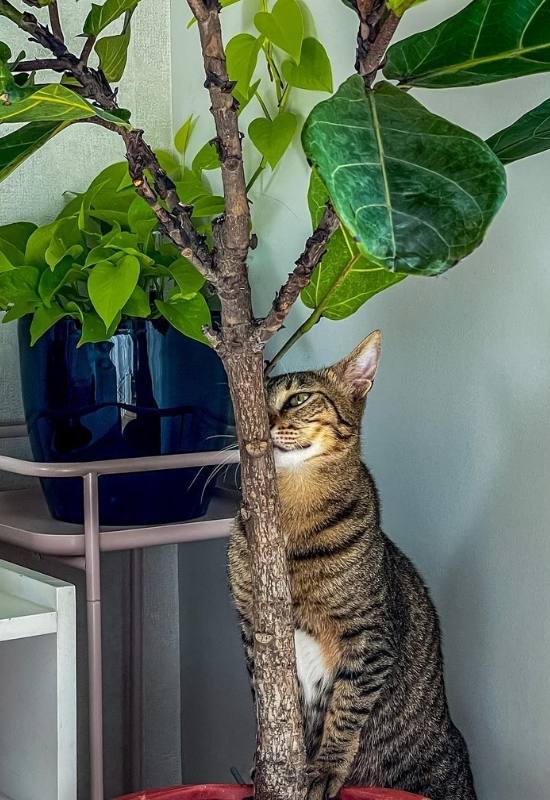Fiddle Leaf Fig Plants and Cats: What Every Pet Lover Must Know Now!

The first time I realized just how determined a cat could be, I watched my tuxedo cat, Juniper, scale a narrow curtain rod to bat at a dangling pothos vine. That was my crash course in feline physics and plant safety. It’s not enough to tuck a plant on a high shelf—these animals turn your living room into an obstacle course.

So when I brought home my first fiddle leaf fig (Ficus lyrata) back in late 2018, I was so focused on its glossy leaves and Instagram potential that I overlooked one thing: those lush plants can spell trouble for curious cats. Here’s what actually happens—and what genuinely works—if you want both healthy houseplants and thriving pets.

Why Fiddle Leaf Figs Are Risky (and What It Looks Like)
Here’s what most guides gloss over: the risk isn’t just “toxicity.” The real culprit is calcium oxalate crystals—microscopic spikes embedded in every part of the plant. When your cat chews on a fiddle leaf fig, those crystals get lodged in their mouth, tongue, or throat. Picture biting into fiberglass insulation: sharp pain, instant irritation.
When my neighbor’s Maine Coon sampled her fig last spring, the signs were textbook but alarming:
- Sudden drooling
- Reluctance to swallow food or water
- Pawing at the mouth like he’d tasted hot sauce
She called me in a panic; we rinsed his mouth with cool water (he did NOT appreciate this) and monitored him for swelling or breathing trouble.

The “Put It High” Fallacy—and How Cats Outsmart Us
If your kneejerk solution is to put the plant up high? Let me save you some trial and error: this only works if your cat has zero vertical ambition—which describes exactly zero cats I’ve known. My own attempts included:
- A floating shelf (Juniper leapt from the arm of my couch)
- Inside an open terrarium (she stuck her paw through the vent holes)
- On top of the fridge (she used a chair as a launch pad)
After three months and two close calls—plus one toppled pot—I realized it wasn’t about outsmarting her; it was about real deterrence.

Field-Tested Tactics That Actually Work
-
Closed Doors Win
If you’re set on keeping toxic plants: dedicate one room as your “greenhouse,” keep it closed off with no kitty access. In my case: office door shut = no midnight munchies. -
Glass Cloche Domes
Found at home goods stores for ~$25-$40. These make any tabletop plant look high-end and block direct access. The downside? Only fits smaller plants, but perfect for young figs. -
Cat-Safe Distraction Strategy
Cat grass trays changed everything for me—a $4 tray from Petco placed right by Juniper’s favorite window meant she lost interest in forbidden foliage almost overnight. -
Training Reinforcement
Every time she sniffed at something off-limits, I redirected her with treats or toys by the cat grass instead of scolding (which honestly never worked). Consistency mattered more than volume; within two weeks she’d stopped testing boundaries. -
Routine Plant Audits
Every month or so, do a quick sweep: check soil for loose bits (cats love digging), trim droopy leaves that might tempt bored felines, and rotate out any plants that start looking nibbled. -
Emergency Prep
Keep your vet’s number in your phone contacts under “Emergency,” not buried in paperwork somewhere.- Pro tip from experience: Take photos if you see chewed leaves or symptoms—the vet will ask exactly what happened and when.

A Quick Note on Vet Visits & Real Risks
Most cats who nibble fiddle leaf fig won’t need intensive treatment—but don’t gamble on luck alone:
- If you spot swelling around lips/tongue or any hint of breathing difficulty? Go straight to emergency care.
- For mild cases: Vets usually recommend flushing out the mouth and monitoring hydration/appetite over 24 hours.
- Cost-wise: Maggie paid $60 for her consult; our local ER quoted $150+ if IV fluids were needed (thankfully they weren’t).
Safe Alternatives With Cat Approval Ratings
No theory here—these are battle-tested by multiple cats through years of trial:
- Spider Plant (Chlorophytum comosum): Endlessly chewable fronds
- Areca Palm (Dypsis lutescens): Big statement piece without worry
- Boston Fern: Lush texture; tolerates some rough pet play
I’ve never had a single issue with these—even after Juniper decided to nap inside the spider plant pot one afternoon.
Final Word: Choose Your Battles
The biggest lesson? You can absolutely have beautiful greenery and safe pets—but it requires more intention than impulse buys at the nursery. Don’t rely on shelf height alone; use physical barriers where possible, give your cat approved greens to munch, and always know how to reach help fast if curiosity gets out of hand.
And maybe most important—don’t beat yourself up for learning as you go! Every seasoned pet parent has their own story (“Remember when Boots ate half a fern?”). You’re part of an ever-growing club that balances beauty with safety—and wins, day after day.
So go check those shelves—and give yourself credit for caring enough to ask before disaster strikes!



